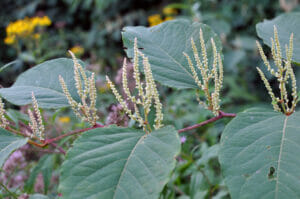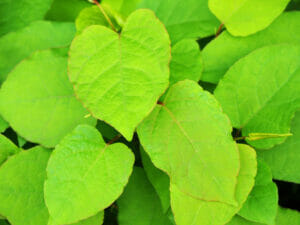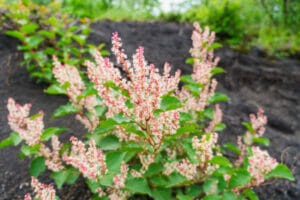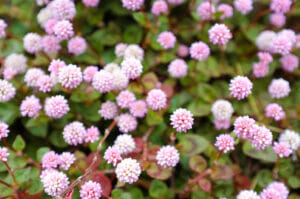Many private residential and commercial land owners are aware of the invasive plant Japanese Knotweed and the associated problems that come with it. With its white flower tassels, shield-shaped leaves and purple flecked bamboo-like stems, the plant has become infamous in the UK. A quick internet search will throw up the key pointers for Japanese knotweed identification. But, is it possible to find pink knotweed or, specifically, can Japanese knotweed have pink flowers?

The white flowers of Japanese knotweed (Reynoutria japonica) iStock.com/ Orest Lyzhechka
Keeping it in the knotweed family
The majority of knotweed information found is for the most publicised species, Reynoutria japonica (synonyms Fallopia japonica and Polygonum cuspidatum), or as it is commonly known, Japanese knotweed. For homeowners, finding a plant species with pink flowers and knotweed characteristics can cause confusion. If you come across such a plant, the good news is that your eyes are not deceiving you. What you may think concerning, is that pink knotweed flowers do occur. You could be looking at a ‘cousin’ of Reynoutria japonica, known as Pink knotweed, or another more closely related variety, known as Dwarf knotweed.
It may come as no surprise that all of the plants referenced, including Japanese knotweed, come from the same subfamily of plants, Polygonoideae. This goes some way to explain the many similarities or shared characteristics. For example, most are herbaceous perennials with swollen nodes, alternate leaf arrangements, and possess flower spikes. And, plants from this subfamily typically have flowers that are white, pink, or red. Although, certain species have other colours.
The subfamily, Polygonoideae, in which Japanese knotweed resides, contains both ornamental and some of the most renowned invasive plants. These include, UK Wildlife and Countryside Act [1981] Schedule 9 listed plants: Japanese knotweed, Giant knotweed and Hybrid knotweed. However, they also include invasive varieties of Persicaria Listed on the EU’s List of Invasive Alien Plants of Union Concern (2022): Asiatic tearthumb (Persicaria perfoliata) and Himalayan knotweed (Persicaria wallichii). The UK listed invasive plants are closely related to Dwarf knotweed, and the European ones (the Persicaria) to Pink knotweed.
What is Pink knotweed?
Known by its Latin name, Persicaria capitata, Pink knotweed is a low growing, hardy and appears a pretty and benign garden plant. The plant is considered by many to be ornamental; however, it can form a dense mat of low-level growth given the right conditions. Despite being a Persicaria, this particular species is not listed as an invasive plant in UK or European legislation.
The main characteristics of Pink knotweed include:
- A dense low growing mat up to 5 ft/1.5m across and 6in/15cm high
- Lanceolate (lance shaped) leaves ranging from 2-11 inches long
- Leaves with a red edge and distinct red chevron across the top
- Pink flowers arranged in a cluster (inflorescence) at the end of bright red stalks
- Red flower stalks that grow out above and over the foliage
The flowers of Persicaria capitata (synonym Polygonum capitatum) up close iStock.com/LF062
Pink knotweed can be both perennial and annual. In hot climates it will be perennial and it will become annual in cooler climates. The species is highly adaptive and, although it prefers damp conditions, will happily make do and start to spread. Persicaria capitata can regenerate both sexually, via its flowers, and vegetatively form hardy rhizomal root structures. Flowering happens randomly, and it can flower once and then never again.
Having identified pink flowered knotweed on your land, the next most likely question will likely be: does it need to be removed?
What should be done about Pink knotweed?
There is not the same legal obligation to remove or stop the spread of Pink knotweed, as there is with the more common Japanese knotweed. Persicaria capitata, is not on the list of controlled or prohibited plants listed under the UK Wildlife and Countryside Act [1981] and is not listed in European legislation. It is not illegal to cultivate or grow Persicaria capitata in the UK. However, it should be noted that Pink knotweed does have the capacity to become an environmental weed.
When planning to grow Persicaria capitata in the UK, it is recommended to do so responsibly. Take necessary precautions to prevent it from spreading uncontrollably. As the plant can thrive and overrun an area of garden, you may decide to control or remove it. Pink knotweed can be effectively controlled with herbicide treatment. And, it can be dug up or excavated for removal purposes. However, care should be taken because, like its relatives the plant can grow from the smallest part of rhizome left in the soil.
Dwarf knotweed can have pink flowers too!
Dwarf knotweed (Reynoutria Japonica var. Compacta) is another relative of Japanese knotweed that can produce pink flowers. Less aggressively invasive than its relatives, but still potentially a nuisance, and known to hybridise with Giant knotweed (Reynoutria Sachalinensis). As with Pink knotweed, Dwarf knotweed can reproduce both sexually and vegetatively.

The crinkled-edged leaf of a Dwarf knotweed plant (Reynoutria Japonica var. Compacta)©ANGHI via Canva.com
The main characteristics of Dwarf knotweed are:
- A small plant growing no more than 1m in height
- Heart-shaped dark green leaves – rounder than Japanese knotweed – with crinkly edges 7-11cm in length
- White and pink flowers in tassels
Dwarf Japanese knotweed produces its pink and white flowers in early autumn/late summer. Its purple veined heart-shaped leaves turn a distinctive red in the autumn.

Flowering Dwarf knotweed (Reynoutria japonica var. Compacta) ©T-Tadanobu via Canva.com
Is there a need to deal with Dwarf knotweed?
Dwarf knotweed is also not specifically named on the Schedule 9 list of controlled plants. However, the Wildlife and Countryside Act states that ‘Plant refers to species in the kingdom Planate’. As such, being a varietas, Dwarf knotweed is bound by the same rules as Japanese knotweed. It is not illegal to grow it on your land, but there is an obligation to prevent the plant from spreading from your land into the wild.
What is less clear is the legal obligation with regard to the transfer of property. The TA6 form required for the transfer of a residential property specifically names Japanese knotweed, other varieties are not referenced. The issue being one of nomenclature. Japanese knotweed is commonly used as a catchall term for four knotweed species present in the UK.
Removing or treating Dwarf knotweed
As the Latin name implies, Dwarf knotweed is essentially a compact version of Japanese knotweed, as such it achieves a lower height and is less able to shade out all competing vegetation. It does however possess invasive properties, and Government Guidance lists it as one of the 4 invasive knotweeds in the UK.
As with all knotweed varieties, Dwarf knotweed can be difficult to eradicate and in doing so care should be taken to prevent its spread. The species is best eradicated with a combination of both excavation and herbicide treatment. Experts will be able to identify and remove traces of root from the soil and have access to the most effective herbicide treatments. For this reason, it may be more effective to work with a professional PCA accredited Japanese knotweed removal company when attempting to control or eradicate any knotweed variety from your property.
In conclusion
If you see a plant on your property that looks like Japanese knotweed but has pink flowers, it is likely one of Reynoutria japonica’s close ‘cousins’. Although these relatives are not as aggressive as the infamous Japanese knotweed, both are capable of getting out of control and one (Dwarf knotweed) you have an obligation to ensure it doesn’t. Once this happens, both plants will prove more difficult to curtail or remove.
If you want to deal with Dwarf knotweed or Pink knotweed on your property it may be easier to call in the professionals. Call 0203 174 2187 or 01202 816134 to get advice from one of our consultants today.


